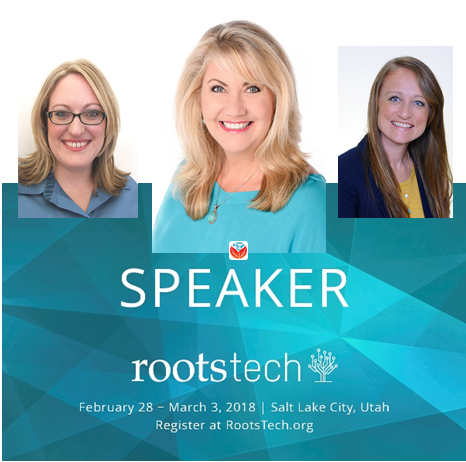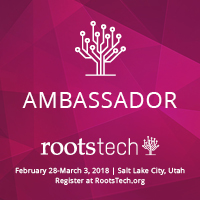RootsTech 2018 Pass Giveaway (and More Exciting RootsTech News)
Our RootsTech 2018 pass giveaway is underway! Enter by November 15, 2017 to win a chance to attend the world’s biggest genealogy event for FREE. Meanwhile, there’s more RootsTech news: the class schedule is posted and two keynote speakers have been announced. We think you’ll want to go! The real question is, will you get in for free?

It’s time to give away a RootsTech 2018 pass to one lucky Genealogy Gems fan! This is a great prize: all-access admission to the world’s biggest genealogy event at the Salt Palace Convention Center in Salt Lake City, UT, February 28 – March 3, 2018. It’s a $279 value! Keep reading to see how to enter. But first, a quick update on RootsTech 2018.
The Latest RootsTech 2018 News
RootsTech is:
- A conference. Choose from more than 300 classes on traditional research skills, DNA, tech tools, photos, stories, and organizing.
- A convention. The biggest names in the genealogy industry share a huge Expo Hall with hundreds of other vendors, societies, and services. All want to answer your questions and show you the latest and greatest tools and resources to help your research.
- A party. There’s no denying the fun, festive atmosphere of RootsTech. There are world-class keynote speakers (Olympic figure skater Scott Hamilton and “Humans of New York” Brandon Stanton) and dazzling evening entertainment (love the 1940s extravaganza this year!).
This short highlights video captures it all. Check it out:
 The RootsTech class schedule has been published. I’m super excited about classes being taught this year by the Genealogy Gems team. Just one example: Google Earth guru Lisa Louise Cooke and Your DNA Guide Diahan Southard are teaming up to deliver a powerhouse talk about putting your DNA matches on the map. Click here to see the full Genealogy Gems lineup.
The RootsTech class schedule has been published. I’m super excited about classes being taught this year by the Genealogy Gems team. Just one example: Google Earth guru Lisa Louise Cooke and Your DNA Guide Diahan Southard are teaming up to deliver a powerhouse talk about putting your DNA matches on the map. Click here to see the full Genealogy Gems lineup.
RootsTech 2018 Pass Giveaway
We have a RootsTech Full Registration Pass to give to one lucky winner! This pass includes* access to over 300 classes, keynote/general sessions, the Innovation Showcase, Expo Hall and evening events. (Click here for more info about RootsTech 2018.) All you have to do to enter is take our 5-question survey by midnight (CT) on November 15, 2017.
Can’t attend Rootstech? Enter anyway for a chance to win a 1-Year Genealogy Gems Premium Membership!** Everyone who completes the survey below will be automatically entered to win.
We want your input: We know many people are not able to attend RootsTech in person, and that’s why we hope to make several of our booth classes available on video. Tell us which topics you want to see, and help us continue to make Genealogy Gems the best it can be.
Rules: Must complete survey by 12:00 am CT on November 15, 2017 to be eligible. No purchase necessary. Winners announced and notified on November 16, 2017. *RootsTech 4-Day Pass only covers registration (does not include airfare, hotel, or other expenses). If the winner has already registered for RootsTech 2018, the original registration fee will be refunded. **Premium Membership prize eligible for both new members and renewals. Non-transferable and no cash refund.

Family History Episode 20 – The Genealogical Proof Standard
Originally published 2009. Republished February 25, 2014
https://lisalouisecooke.com/familyhistorypodcast/audio/fh20.mp3
Download the Show Notes for this Episode
Welcome to this step-by-step series for beginning genealogists—and more experienced ones who want to brush up or learn something new. I first ran this series in 2008-2009. So many people have asked about it, I’m bringing it back in weekly segments.

Episode 20: The Genealogical Proof Standard
In this episode we are going to cover a powerful process for doing your genealogy research. It’s called the Genealogical Proof Standard or GPS.
If you’re new to research you may hear some terms that you’re not familiar with. This is the ideal time to start getting familiar with them because it may save you going back and re-doing some of your hard work later down the road.
If you’re an experienced researcher, you may already have had some experience with the GPS. But even if you have, you likely haven’t heard it quite like this. My very special guest is Mark Tucker, a software architect by day and an avid genealogist evenings and weekend. And it’s safe to say Mark has a passion for genealogy and he brings his computing expertise to genealogy in some pretty exciting ways, most recently by process mapping the Genealogical Proof Standard – the GPS – into a visual aid that will help you navigate your way to a successful family tree. (Update: Mark’s Think Genealogy blog is no longer available.)
In our first segment Mark tells us how he got started using the Genealogical Proof Standard, why he created the GPS map, and what it will do for you to improve your genealogy research. Then he gives us an overview of the Genealogical Proof Standard and the various tools that go along with it.
In our second segment we talk about how the GPS map can be effectively used for breaking down your research brick walls.
What is the GPS?
The Genealogical Proof Standard speaks to the quality of our genealogy research process, as outlined in the BCG Genealogical Standards Manual. BCG stands for the Board of Certification of Genealogists, and it’s an internationally recognized organization that certifies qualified genealogists who meet their standards.
The idea behind the GPS is that it provides standards generally accepted in the field of genealogy research. Historically the GPS has been thought of in conjunction with professional genealogists. But more and more it is being used by family historians everywhere who want to do a quality job of climbing their family tree.
The Genealogical Proof Standard is really like a process map. It maps out the proven steps that a good genealogist takes to answer their family tree questions.
Proof is a fundamental concept in genealogy. In order for your research to really be accurate and dependable, each conclusion you reach about an ancestor must have sufficient credibility to be considered as proven. To make sure that conclusions you come to about your family are accurate they really need to meet standards of the Genealogical Proof Standard (The GPS). The GPS consists of five major criteria:
- You have to be sure that you have conducted a reasonably exhaustive search.
- You need to have complete and accurate source citations.
- You need to do the analysis and correlation of the information that you’ve found. It’s not just enough to find a fact, you have to look at it within the context of all of the fact and make sure that it fits together in a way that really makes sense.
- If that analysis brings to light the fact that there are conflicts when you put your data together, then your next step is to go back and work to resolve any conflicting evidence. You’ll want to look for additional resources to solve the question at hand.
- You need to be able to write a sound, reasoned, and coherent conclusion. If you can summarize your findings in a way that makes sense and you can show your proof you know that you’re in good shape and your hard work meets the Genealogical Proof Standard.
The GPS is not just a tool for professional genealogists, but it’s also a tool for you and your research. It actually makes a lot of sense, and it’s pretty simple when you break it down into the 5 basic steps:
- Conduct a reasonably exhaustive search;
- Document complete and accurate source citations;
- Analyze and correlate all of the collected information;
- Resolve any conflicting evidence;
- Write a sound reasoned, and coherent conclusion.
GPS Resources
Mark’s Genealogy Research Process Chart and Powerpoint presentation “Navigating Research with the GPS.” (Unfortunately this is no longer available.)
Learn more about Genealogy Ethics and Standards at the Board for Certification of Genealogists.
The Historical Biographer’s Guide to the Research Process Quicksheet, a laminated quick reference guide by Elizabeth Shown Mills.

